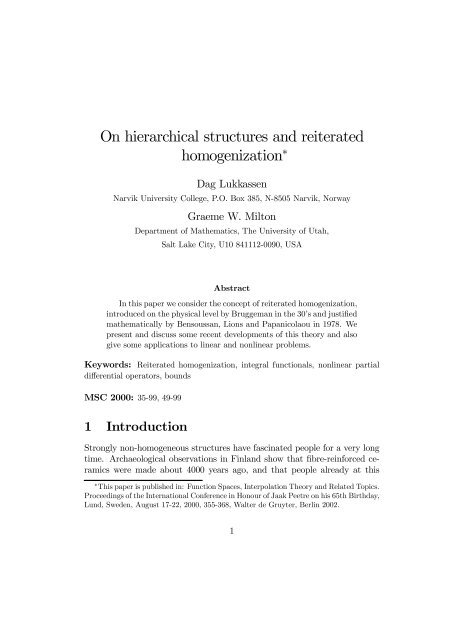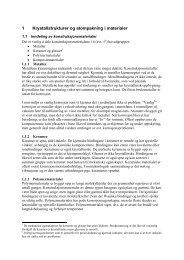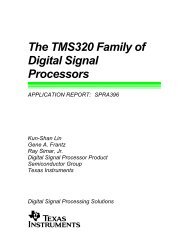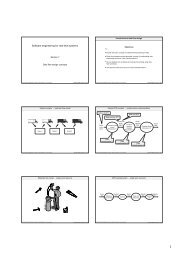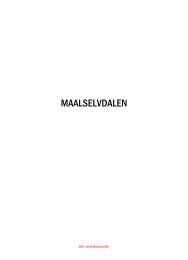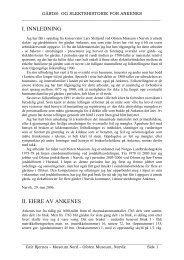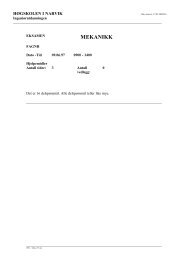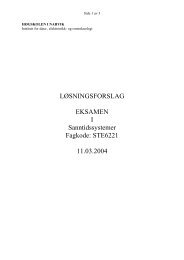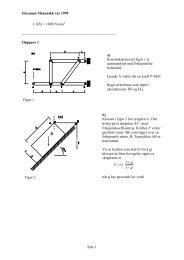On hierarchical structures and reiterated homogenization∗
On hierarchical structures and reiterated homogenization∗
On hierarchical structures and reiterated homogenization∗
Create successful ePaper yourself
Turn your PDF publications into a flip-book with our unique Google optimized e-Paper software.
<strong>On</strong> <strong>hierarchical</strong> <strong>structures</strong> <strong>and</strong> <strong>reiterated</strong><br />
homogenization ∗<br />
Dag Lukkassen<br />
Narvik University College, P.O. Box 385, N-8505 Narvik, Norway<br />
Graeme W. Milton<br />
Department of Mathematics, The University of Utah,<br />
Salt Lake City, U10 841112-0090, USA<br />
Abstract<br />
In this paper we consider the concept of <strong>reiterated</strong> homogenization,<br />
introduced on the physical level by Bruggeman in the 30’s <strong>and</strong> justified<br />
mathematically by Bensoussan, Lions <strong>and</strong> Papanicolaou in 1978. We<br />
present <strong>and</strong> discuss some recent developments of this theory <strong>and</strong> also<br />
give some applications to linear <strong>and</strong> nonlinear problems.<br />
Keywords: Reiterated homogenization, integral functionals, nonlinear partial<br />
differential operators, bounds<br />
MSC 2000: 35-99, 49-99<br />
1 Introduction<br />
Strongly non-homogeneous <strong>structures</strong> have fascinated people for a very long<br />
time. Archaeological observations in Finl<strong>and</strong> show that fibre-reinforced ceramics<br />
were made about 4000 years ago, <strong>and</strong> that people already at this<br />
∗ This paper is published in: Function Spaces, Interpolation Theory <strong>and</strong> Related Topics.<br />
Proceedings of the International Conference in Honour of Jaak Peetre on his 65th Birthday,<br />
Lund, Sweden, August 17-22, 2000, 355-368, Walter de Gruyter, Berlin 2002.<br />
1
time had ideas <strong>and</strong> theories for intelligent combinations of materials <strong>and</strong><br />
<strong>structures</strong>. Analysis of the macroscopic properties of composites was investigated<br />
by the physicists Maxwell, Rayleigh, <strong>and</strong> Einstein, among many others.<br />
Around 1970 the problem of determining the physical properties of material<br />
<strong>structures</strong> <strong>and</strong> composites was reformulated in such a way that this field became<br />
interesting from a purely mathematical point of view. This formulation<br />
initiated a new mathematical discipline called homogenization theory.<br />
Reiterated homogenization was introduced on the physical level by Bruggeman<br />
already in the 30’s. The mathematical justification of this theory was<br />
given by Bensoussan, Lions <strong>and</strong> Papanicolaou in 1978. In this paper we<br />
present <strong>and</strong> discuss some recent developments of this theory <strong>and</strong> also give<br />
some applications to linear <strong>and</strong> nonlinear problems.<br />
2 The periodic case<br />
The conductivity problem on a periodic material structure with period equal<br />
to 1/h can be formulated by the following minimum principle:<br />
µ Z<br />
<br />
Eh =min<br />
u<br />
Fh(u) − u(x)g(x) dx<br />
Ω<br />
, (1)<br />
where<br />
Z<br />
Fh(u) =<br />
¡ 2<br />
λ(hx) |Du(x)| ¢ dx.<br />
Ω<br />
Here, λ(·) (the conductivity) is periodic relative to the unit-cube I of Rn <strong>and</strong> bounded between two strictly positive constants, Ω is a bounded open<br />
subset of Rn <strong>and</strong> g is the source-field. The minimization is taken over some<br />
suitable (subset of a) Sobolev-space which takes care of the given boundary<br />
conditions. It is possible to prove that the energy Eh converges to a ”homogenized”<br />
energy Ehom, as h →∞, of the form<br />
Ehom =min<br />
u<br />
µ<br />
Fhom(u) −<br />
where Fhom is of the form<br />
Z<br />
Fhom(u) =<br />
Ω<br />
Z<br />
Ω<br />
<br />
u(x)g(x) dx , (2)<br />
fhom(Du(x))dx<br />
2
<strong>and</strong><br />
fhom(ξ) = min<br />
W 1,2<br />
per (I)<br />
Z<br />
λ(x) |ξ + Du(x)|<br />
I<br />
2 dx. (3)<br />
Here, W 1,2<br />
per (I) is the space of I-periodic functions of the Sobolev space W 1,2 (I).<br />
Therefore, since the actual energy Eh (which is interesting for us to determine)<br />
is difficult to find when h is large, <strong>and</strong> since fhom(ξ) <strong>and</strong> Ehom can<br />
be found by many numerical methods, we can use Ehom as an approximation<br />
of Eh. The convergence of energies is usually seen as a consequence of<br />
Γ-convergence of the corresponding Lagrangians (see the definition below).<br />
As an alternative to (1) we can formulate the conductivity problem via<br />
the corresponding Euler equation<br />
− div λ(hx)Duh(x) =g,<br />
together with the given boundary conditions. It is possible to prove that the<br />
solution uh (in this case the minimizer of (1)) converges weakly in the above<br />
mentioned Sobolev space to the solution u (in this case also the minimizer<br />
of (2)) of the ”homogenized” equation<br />
− div AhomDu(x) =g.<br />
Here, Ahom is defined by<br />
Z<br />
Ahomξ = λ(x) ¡ Du ξ (x)+ξ ¢ dx,<br />
I<br />
where uξ (in this case also the minimizer of (3)) is the I-periodic solution of<br />
div ¡ λ(x)(Du ξ (x)+ξ) ¢ =0.<br />
The convergence results above were first proved by De Giorgi <strong>and</strong> Spagnolo<br />
in the late 60’s. Various kinds of simplifications of this proof were done<br />
in the 70’s by Murat, Tartar, Bakhvalov, Bensoussan, Lions <strong>and</strong> Papanicolaou<br />
(for more information, see e.g. the book [16]).<br />
3 Reiterated homogenization of integral functionals<br />
Let us consider the class of Lagrangians g such that g(x, ξ) is measurable in<br />
x, convexinξ<strong>and</strong> satisfying the st<strong>and</strong>ard growth condition<br />
−c0 + c1 |ξ| p ≤ g(x, ξ) ≤ c0 + c2 |ξ| p , (4)<br />
3
where c1,c2 > 0 <strong>and</strong> p>1. If gh <strong>and</strong> g belong to this class we recall that g<br />
is the Γ-limit of the sequence gh, denoted g = Γ−lim gh, if for any bounded<br />
open set Ω with Lipschitz boundary the following two conditions hold:<br />
(i) for any uh ∈ W 1,p (Ω), uh uweakly in W 1,p (Ω) it holds that<br />
Z<br />
Ω<br />
g(x, Du)dx ≤ lim inf<br />
h→∞<br />
Z<br />
Ω<br />
gh(x, Du)dx,<br />
(ii) for every u ∈ W 1,p (Ω) there is a sequence uh such that uh uweakly<br />
in W 1,p (Ω) uh − u ∈ W 1,p<br />
0 (Ω),<br />
Z<br />
Ω<br />
g(x, Du)dx = lim<br />
h→∞<br />
Z<br />
Ω<br />
gh(x, Du)dx.<br />
Let f(y, z, ξ) be I-periodic <strong>and</strong> measurable in the first <strong>and</strong> second variable,<br />
respectively. Moreover, assume that f is piecewise continuous in the<br />
first variable, i.e. of the form f(y, z, ξ) = PN i=1 χΩi (y)fi(y, z, ξ), where fi<br />
satisfies<br />
|fi(y, z, ξ) − fi(y 0 ,z,ξ)| ≤ ω(|y − y 0 |)(a(z)+fi(y, z, ξ))<br />
for all y, y 0 ,z,ξ ∈ R n ,whereω <strong>and</strong> a are continuous positive real functions<br />
with ω(0) = 0. Inthethirdvariableweletf be convex <strong>and</strong> satisfying the<br />
growth condition (4).<br />
Theorem 1 We have the existence of the Γ-limit fhom = Γ−lim fh where<br />
fh(x, ξ) =f(hx, h 2 x, ξ). Moreover,<br />
fhom(ξ) =f [2] (ξ),<br />
where f [2] is found iteratively according to the following scheme:<br />
f [2] (ξ) = min<br />
u∈W 1,p<br />
Z<br />
f<br />
per (I) I<br />
[1] (y, ξ + Du(y))dy<br />
Z<br />
f [0] (x,y, ξ + Du(y))dy<br />
f [1] (x, ξ) = min<br />
u∈W 1,p<br />
per (I)<br />
f [0] (x, y, ξ) = f(x, y, ξ).<br />
4<br />
I
Figure 1: The laminate structure of rank 2. Here, m = 2 (h is a fixed<br />
number).<br />
The above theorem is easily extended to the case fh(x, ξ) =f(hx, ..., h m x, ξ)<br />
in which<br />
fhom(ξ) =f [m] (ξ),<br />
where f [m−j] is found iteratively according to the following scheme:<br />
Z<br />
f [m−j−1] (x1, ..., xj,y, ξ + Du(y))dy<br />
f [m−j] (x1, ..., xj,ξ) = min<br />
u∈W 1,p<br />
per (I)<br />
f [0] (x1, ..., xm,ξ) = f(x1, ..., xm,ξ).<br />
I<br />
In Figure 1 <strong>and</strong> Figure 2 we have illustrated examples where fh(x, ξ) =<br />
λ(hx, h 2 x) |ξ| 2 .InFigure1<br />
λ(x, y) =2− k(x1)k(y2)<br />
<strong>and</strong> in Figure 2<br />
λ(x, y) =2− k(x1)k(x2)k(y1)k(y2),<br />
where<br />
½<br />
1<br />
0 t ∈ [0 + n, + n><br />
k(t) =<br />
3<br />
1 t ∈ [ 1<br />
,nis an integer.<br />
+ n, 1+n> 3<br />
The conductivity λ(hx, h2x) takes the value 2 when x is in the black part<br />
<strong>and</strong> the value 1 when x is in the white part, respectively.<br />
5
Figure 2: The <strong>reiterated</strong> cube structure for m =2(h is a fixed number).<br />
Remark 1 Theorem 1 of Braides <strong>and</strong> Lukkassen [9, 22] is a generalization<br />
of the case of quadratic forms given by Bensoussan, Lions <strong>and</strong> Papanicolaou<br />
in the book [7] where the concept of <strong>reiterated</strong> homogenization was introduced.<br />
Later on Müller, Braides <strong>and</strong> Defranceschi generalized this result to st<strong>and</strong>ard<br />
non-convex Lagrangians (see [8]). The corresponding proofs are quite different.<br />
Remark 2 In its form Theorem 1 (<strong>and</strong> likewise its non-convex cousin) is<br />
a natural generalization of the periodic case, <strong>and</strong> agrees with the physical<br />
intuition that the effective properties should be obtained by first homogenizing<br />
the medium on the finest microlevel <strong>and</strong> next on the second one. However,<br />
in the case of non-st<strong>and</strong>ard Lagrangians, satisfying the growth condition<br />
−c0 + c1 |ξ| q ≤ f(x, y, ξ) ≤ c0 + c2 |ξ| p , (5)<br />
an unexpected phenomenon occurs: In contrast to the periodic case the limit<br />
Γ−lim fh may not exist (see [25])! However, by compactness we always have<br />
the existence of Γ-converging subsequences. It is possible to show that all such<br />
limits are sharply bounded between two Lagrangians whose representation can<br />
be found iteratively by a more general scheme than that above. These bounds<br />
are strongly dependent on the power q <strong>and</strong> p of the Sobolev-spaces involved<br />
<strong>and</strong> they are (certainly) equal when q = p. Non-trivial examples can be found<br />
where these bounds are attained.<br />
6
4 Reiterated homogenization of differential<br />
operators<br />
We consider the class of partial differential equations of the form<br />
− div(aε(x, Duε)) = F on Ω, uε ∈ W 1,p<br />
0 (Ω), (6)<br />
where Ω is an open bounded subset of R n , 1
where v ξ is the unique solution of the cell-problem<br />
R<br />
Y (b1(y, ξ + Dv ξ (y)),Dφ) dy =0for every φ ∈ W 1,p<br />
per (Y ),<br />
v ξ ∈ W 1,p<br />
per (Y ).<br />
Moreover, the operator b1 : Y × Rn → Rn is given by<br />
b1(y, ξ) = 1<br />
Z<br />
a(y, z, ξ + Dv<br />
|Z|<br />
ξ,y (z)) dz,<br />
Z<br />
where v ξ,y is the unique solution of the cell-problem<br />
R<br />
Z (a(y, z, ξ + Dvξ,y (z)),Dφ) dz =0for every φ ∈ W 1,p<br />
per (Z),<br />
v ξ ∈ W 1,p<br />
per (Z).<br />
Definition 3 We say that a sequence uε 3-scale converges to u0(x, y, z) ∈<br />
Lp (Ω,Y,Z) if<br />
Z ³<br />
lim uε(x)ϕ x,<br />
ε→∞<br />
x x<br />
,<br />
ε ε2 ´<br />
dx =<br />
Ω<br />
1<br />
Z<br />
u0(x, y, z)ϕ (x, y, z) dx dy dz<br />
|Y ||Z| Ω×Y ×Z<br />
for all ϕ ∈ D(Ω; C ∞ per(Y,Z)) (which means functions ϕ(x, y, z) being C ∞ with<br />
compact support in x with values of functions which are C ∞ <strong>and</strong> periodic in<br />
y <strong>and</strong> z).<br />
It is possible to extend Theorem 2 to the case aε(x, ξ) =a(x, x/ε, x/ε 2 ,ξ).<br />
In the following theorem we let aε be of this form.<br />
Theorem 4 Let uε be a solution of (6). Then as ε → 0, it holds that uε 3scale<br />
converges to u0 ∈ W 1,p<br />
0 (Ω) <strong>and</strong> Duε 3-scale converges to Du0 + Dyu1 +<br />
Dzu2, where{u0,u1,u2} is a solution of<br />
Z<br />
1<br />
a(x, y, z, Du0 + Dyu1 + Dzu2)(Dv0 + Dyv1 + Dzv2)dx dy dz =<br />
|Y ||Z| Ω×Y ×Z<br />
Z<br />
= Fv0dx<br />
for all v0 ∈ W 1,p<br />
0 (Ω), v1 ∈ L p (Ω; W 1,p<br />
per (Y )), v2 ∈ L p (Ω; W 1,p<br />
per (Y × Z)).<br />
Ω<br />
8
Remark 3 The iterated homogenization theorem for monotone operators,<br />
Theorem 2, was proved by Lions, Lukkassen, Persson <strong>and</strong> Wall in [20, 21].<br />
Remark 4 The concept of multiscale convergence was used by Allaire <strong>and</strong><br />
Briane [2] to study linear homogenization problems with several scales (which<br />
generalizes the concept of 2-scale convergence of Allaire <strong>and</strong> Nguetseng [1,<br />
37]). The proof of the nonlinear version given in Theorem 4 can be found in<br />
[21].<br />
Remark 5 Theorem 2 <strong>and</strong> Theorem 4 can easily be extended to the case<br />
when aε is on the form aε(x, ξ) =a(x,x/ε,...,x/ε m ,ξ). Following an idea<br />
of Bensoussan <strong>and</strong> Lions [6] the case of infinitely many scales for linear<br />
problems was also studied by Allaire <strong>and</strong> Briane [2]. It seems to be possible<br />
to generalize such results to monotone problems as well.<br />
4.1 Differential effective medium theory<br />
Since <strong>reiterated</strong> homogenization is quite natural from a physical point of<br />
view (see Remark 2) it does not come as a surprise that <strong>reiterated</strong> techniques<br />
were used long before the homogenization theory itself was developed. Such<br />
techniques led to the so called differential effective medium theory (DEM)<br />
introduced in the 30’s by Bruggeman [10] for materials with two phases <strong>and</strong><br />
generalized by Norris to multiphase materials [38]. For two-phase materials<br />
the theory is roughly speaking as follows: Let C be the tensor of a ”matrix<br />
material”, let C1 be the tensor of the ”inclusion material” <strong>and</strong> let c be the<br />
volume fraction of the inclusion material. Moreover, suppose that for small<br />
c <strong>and</strong> all C we have<br />
Ceff = C + cQ(C)+O(c 2 ), (7)<br />
where Q is a continuous function. Then, the system of ordinary differential<br />
equations<br />
dC<br />
= Q(C(t))<br />
dt<br />
gives a representation of the realizable effective properties which can be obtained<br />
from an initial material C0 by iterating (7) (an incremental procedure).<br />
It was rigorously proved by Milton [30, 31] that Bruggeman’s differential<br />
scheme with spherical inclusions corresponds to a differential microstructure.<br />
Later on this result was generalized by Avellaneda [4].<br />
9
For more detailed information on DEM <strong>and</strong> its application we refer to<br />
Avellaneda [4]. Other interesting variants <strong>and</strong> applications can be found<br />
in the works of Beliaev <strong>and</strong> Kozlov [5], Jikov <strong>and</strong> Kozlov [15] <strong>and</strong> Kozlov<br />
[18]. For the case of DEM <strong>and</strong> <strong>reiterated</strong> homogenization of linear equations<br />
with r<strong>and</strong>om coefficients, see Kozlov [17]. DEM can also be used in case of<br />
nonlinear problems (see [26]).<br />
5 Further applications<br />
By combining some suitable bounds for nonlinear homogenized functionals<br />
with the nonlinear versions of the iterated homogenization above it is possible<br />
to give very sharp estimates of the homogenized functional also in cases<br />
when it cannot be computed exactly. These estimates can be used to study<br />
some two-component <strong>reiterated</strong> <strong>structures</strong> with rather surprising macroscopic<br />
behavior. In [9] <strong>and</strong> [22] three types of <strong>structures</strong> were analyzed: the laminate<br />
structure (Figure 1), the iterated cube structure (Figure 2) <strong>and</strong> a mixed<br />
iterated structure (Figure 5), the latter being a mixture of the first two<br />
<strong>structures</strong> <strong>and</strong> a structure of chess-board type. In particular, in [9] <strong>and</strong> [22]<br />
we pointed out some cases where the macroscopic behaviors of the iterated<br />
cube structure <strong>and</strong> the mixed <strong>reiterated</strong> structure possess a higher or lower<br />
effective energy density than that of the best possible laminate structure of<br />
rank n (where n isthedimensionofthespace). Thefactthatthishasproven<br />
to be impossible for two-phase linear conductivity problems makes these<br />
<strong>structures</strong> particularly interesting (it should be mentioned that infinite rank<br />
laminates do as well as these <strong>structures</strong> in the non-linear case). Moreover,<br />
the results in [9] imply that the effective properties corresponding to the<br />
mixed <strong>reiterated</strong> structure are extremely sensitive to the growth on the local<br />
energy density. Other examples of surprising phenomena have been reported<br />
for nonlinear iterated checkerboard <strong>structures</strong> [25].<br />
Reiterated homogenization of linear elliptic operators <strong>and</strong> effective differential<br />
medium theory has proven to be an important tool in the construction<br />
of iterated laminates <strong>and</strong> other iterated <strong>structures</strong> with optimal effective behavior.<br />
The discoveries so far even include globally isotropic <strong>structures</strong> with<br />
negative Poisson’s ratio (for more information see Milton [33] <strong>and</strong> Lakes [19]).<br />
Concerning optimal <strong>structures</strong> <strong>and</strong> bounds on effective material properties<br />
in general we refer to the collection of classical papers [12], where the introduction<br />
gives a good selection of references, <strong>and</strong> particularly the recent book<br />
10
Figure 3: Iterated hexagonal honeycombs (illustrated for m =3).<br />
of Milton [34]. Here, we only mention a few examples of optimal iterated<br />
<strong>structures</strong>. Concerning optimal iterated laminates for the conductivity problem<br />
see Lurie <strong>and</strong> Cherkaev [27], Milton [29], Schulgasser [42] <strong>and</strong> Tartar<br />
[45]. <strong>On</strong> optimal micro<strong>structures</strong> for the elasticity case in two-dimensions<br />
(transversely isotropic case) there exist periodic (i.e. non-iterated) geometries<br />
found by Vigdergauz [46, 47, 48, 49, 50] which are optimal for the effective<br />
bulk modulus. A very readable treatment of his work can be found in<br />
[14]. There is also a new class of optimal iterated <strong>structures</strong> found recently<br />
by Sigmund [43]. For the effective shear modulus, there appear to be no<br />
”simple micro<strong>structures</strong>”. All known ones have structure on at least 5 wellseparated<br />
length scales (iteration levels). They simultaneously attain both<br />
the shear <strong>and</strong> bulk modulus bounds. The result that the Hashin-Shtrikman<br />
shear bound is attained is in essence in an article of Roscoe [41]. The only<br />
missing part is a rigorous proof that the differential scheme (in the effective<br />
differential medium theory) corresponds to some geometry. Such a proof can<br />
be found in Avellaneda [4]. Independent of this, the attainability of the shear<br />
modulus bound has been shown by Norris [38], Francfort <strong>and</strong> Murat [13] <strong>and</strong><br />
Milton [32]. There was also an appendix in a preprint of Lurie <strong>and</strong> Cherkaev,<br />
written during the same time, that showed realizability. Unfortunately their<br />
paper was published without the appendix. Another iterated structure which<br />
yieldsthesameeffective behavior can be found in [24] (by similar methods<br />
one can also verify that this even holds for iterated triangular honeycombs).<br />
Moreover, in that paper (see also [22]) an iterated cube structure consisting<br />
of m iteration levels was analyzed for the elasticity <strong>and</strong> the conductivity<br />
problem. In particular it was proven that this structure turns optimal in the<br />
class of square symmetric <strong>structures</strong> when m →∞for the elasticity case <strong>and</strong><br />
11
Figure 4: Globally isotropic <strong>structures</strong> with negative Poisson’s ratio (of Milton).<br />
also optimal with respect to effective conductivity (recently, we have become<br />
aware of the fact that in the conductivity case this was already proven in<br />
[17] for a very similar structure. The derivation, though, is different). Similar<br />
results were obtained for iterated hexagonal honeycombs in [23] for the<br />
conductivity case (see Figure 3). It is also possible to prove optimality for<br />
the effective bulk modulus for these <strong>structures</strong>. For numerical computations<br />
on such <strong>structures</strong> we refer to [11].<br />
For non-well ordered materials the same micro<strong>structures</strong> attain the bulk<br />
modulus bounds. In three dimensions the Walpole bound on the shear moduluscanbeimprovedasshownin[28,35].<br />
Intwodimensionsitisnotknown<br />
if the Walpole bounds can be improved. Microgeometries found by Sigmund<br />
(see above) come close to attaining them. There are also a number of papers<br />
on optimal microgeometries for multiphase materials (see [34] <strong>and</strong> the<br />
references given there). Besides these <strong>structures</strong> there is also another familyofmicro<strong>structures</strong>introducedin[34]inthenameofpartial<br />
differential<br />
micro<strong>structures</strong>.<br />
6 A final comment<br />
The homogenized integr<strong>and</strong> fhom(ξ) can be seen as some kind of average of<br />
the local function fh(·,ξ). Inthelaminatecaseweevenhaveadirectlink<br />
to the well known arithmetic <strong>and</strong> harmonic mean. A similar example is the<br />
12
Figure 5: A mixed iterated structure.<br />
checkerboard structure for which fhom(ξ) =g(λ) |ξ| 2 , where g(λ) denotes the<br />
geometric mean. Power means <strong>and</strong> compositions of such means often serve as<br />
upper <strong>and</strong> lower bounds for fhom(ξ) (see e.g. [22], [26], [36] <strong>and</strong> [44]). Hence,<br />
there is an obvious link between <strong>reiterated</strong> homogenization <strong>and</strong> iteration of<br />
means. The latter subject has fascinated many (see e.g. Jaak Peetre [3], [39],<br />
[40] <strong>and</strong> the references given there).<br />
References<br />
[1] G. Allaire. Homogenization <strong>and</strong> two-scale convergence. SIAMJ.Math.<br />
Anal., 23,6 (1992), 1482-1518.<br />
[2] G. Allaire <strong>and</strong> M. Briane, Multiscale convergence <strong>and</strong> <strong>reiterated</strong> homogenization,<br />
Proceedings of the Royal Society of Edinburgh, 126A (1996),<br />
297-342.<br />
[3] J. Arazy, T. Claesson <strong>and</strong> J. Peetre, Means <strong>and</strong> their iterations, Proceedings<br />
of the Nineteenth Nordic Congress of Mathematics, Reykjavik<br />
(1984), 191-212.<br />
[4] M. Avellaneda, Iterated homogenization, differential effective medium<br />
theory <strong>and</strong> applications, Commun. Pure Appl. Math., 40 (1987), 527-<br />
554.<br />
13
[5] A. Beliaev <strong>and</strong> S.M. Kozlov, Hierarchical <strong>structures</strong> <strong>and</strong> estimates for<br />
homogenized coefficients, Russian Journal of Math. Phys., 1, 1 (1993),<br />
5-18.<br />
[6] A. Bensoussan <strong>and</strong> J.L. Lions, Homogenization with an infinite number<br />
of periodic arguments (unpublished notes).<br />
[7] A. Bensoussan, J.L. Lions <strong>and</strong> G.C. Papanicolaou, Asymptotic Analysis<br />
for Periodic Structures, North Holl<strong>and</strong>, Amsterdam, 1978.<br />
[8] A. Braides <strong>and</strong> A. Defranceschi, Homogenization of Multiple Integrals,<br />
Oxford University Press, 1998.<br />
[9] A. Braides <strong>and</strong> D. Lukkassen, Reiterated homogenization of integral<br />
functionals, Math.Mod.Meth.Appl.Sci,10,1(2000),47-71.<br />
[10] D. A. G. Bruggeman, Berechnung verschiedener physikalisher konstanten<br />
von heterogenen substanzen, Ann. Physik. 24 (1935), p. 634.<br />
[11] J. Bystrøm, J. Helsing <strong>and</strong> A. Meidell, Some computational aspects of<br />
iterated <strong>structures</strong>, Composites Part B, 32, 6 (2001), 485-490.<br />
[12] A. Cherkaev <strong>and</strong> R. Kohn (eds), Topics in mathematical modelling of<br />
composite materials, Birkhäuser, Bosten, 1997.<br />
[13] G.A. Francfort <strong>and</strong> F. Murat, Homogenization <strong>and</strong> optimal bounds in<br />
linear elasticity, Arch.Rat.Mech.Anal.,94 (1986), 161—177.<br />
[14] Y. Grabovsky <strong>and</strong> R.V. Kohn, Micro<strong>structures</strong> minimizing the energy of<br />
a two phase elastic composite in two space dimensions. II: The Vigdergauz<br />
microstructure, J. Mech. Phys. Solids, 43 (1995), 949—972.<br />
[15] V.V. Jikov <strong>and</strong> S.M. Kozlov, Multiscaled homogenization, in: Homogenization,<br />
Serguei Kozlov memorial volume, Series on Advances in Mathematics<br />
for Applied Sciences, Vol 50, World Scientific, 1999.<br />
[16] V.V. Jikov, S. M. Kozlov <strong>and</strong> O. A.Oleinik, Homogenization of differential<br />
operators <strong>and</strong> integral functionals, Springer-Verlag, Berlin, 1994.<br />
[17] S.M. Kozlov, A central limit theorem for multiscaled permeability,Transaction<br />
of the Oberwolfach Porous Medium Conference, Birhauser 1993.<br />
14
[18] S.M. Kozlov, Multiscaled approach in homogenization, Proceedings of<br />
the second workshop on Composite media <strong>and</strong> homogenization theory,<br />
217-227, World Scientific, 1995.<br />
[19] R. Lakes, Materials with structural hierarchy, Nature, 361 (1993), 511-<br />
515.<br />
[20] J.-L. Lions, D. Lukkassen, L.-E. Persson <strong>and</strong> P. Wall, Reiterated homogenization<br />
of monotone operators, C. R. Acad. Sci., Paris, Ser. I , Math.<br />
330, 8 (2000), 675-680.<br />
[21] J.-L. Lions, D. Lukkassen, L.-E. Persson <strong>and</strong> P. Wall, Reiterated homogenization<br />
of nonlinear monotone operators, Chin.Ann.Math.,Ser.B,<br />
22, 1 (2001), 1-14.<br />
[22] D. Lukkassen, Formulae <strong>and</strong> bounds connected to optimal design <strong>and</strong><br />
homogenization of partial differential operators <strong>and</strong> integral functionals,<br />
Ph.D.thesis,Dept.ofMath.,TromsöUniversity,Norway,1996.<br />
[23] D. Lukkassen, Bounds <strong>and</strong> homogenization of optimal <strong>reiterated</strong> honeycombs,<br />
in “Computer aided optimum design of <strong>structures</strong> V ” (S.<br />
Hernándes, C. A. Breddia ed.), 267-276 (1997), Computational Mechanical<br />
Publications, Southampton.<br />
[24] D. Lukkassen, A new <strong>reiterated</strong> structure with optimal macroscopic behaviour,<br />
SIAM J. Appl. Math., 59, 5 (1999), 1825-1842.<br />
[25] D. Lukkassen, Reiterated homogenization of non-st<strong>and</strong>ard Lagrangians.<br />
C. R. Acad. Sci., Paris, Ser. I , Math. 332, 11 (2001), 999-1004.<br />
[26] D. Lukkassen, J. Peetre <strong>and</strong> L. E. Persson, <strong>On</strong> some iterated means from<br />
homogenization theory (submitted).<br />
[27] K.A. Lurie <strong>and</strong> A.V. Cherkaev Exact estimates of conductivity of composites<br />
formed by two isotropically conducting media taken in prescribed<br />
proportion. Proc. Roy. Soc. Edinburgh A, 99 (1984), 71—87.<br />
[28] G.W. Milton, Bounds on the electromagnetic, elastic, <strong>and</strong> other properties<br />
of two-component composites, Phys. Rev. Lett. 46 (1981), 542—545.<br />
[29] G.W. Milton, Bounds on the complex permittivity of a two-component<br />
composite material, J.Appl.Phys.52(1981), 5286—5293.<br />
15
[30] G.W. Milton, Some exotic models in statistical physics. I. The coherent<br />
potential approximation is a realizable effective medium scheme. II<br />
Anomalous first-order transitions, Ph.D. thesis, Inst-Cornell, 1985.<br />
[31] G.W. Milton, The coherent potential approximation is a realizable effective<br />
medium scheme, J. Commun. Math. Phys. 99 (1985), 4, 463—500.<br />
[32] G.W. Milton, Modeling the properties of composites by laminates. in:<br />
Homogenization <strong>and</strong> Effective Moduli of Materials <strong>and</strong> Media, ed.by J.L.<br />
Ericksen, D. Kinderlehrer, R. Kohn, <strong>and</strong> J.-L. Lions., The IMA volumes<br />
in mathematics <strong>and</strong> its applications, 1 (1986), 150—174, Springer-Verlag.<br />
[33] G.W. Milton, Composite materials with Poissons ratio close to -1, J.<br />
Mech. Phys. Solids, 49 (1992), 1105-37.<br />
[34] G.W. Milton, The theory of composites, Cambridge University Press,<br />
2001.<br />
[35] G.W. Milton <strong>and</strong> N. Phan-Thien, New bounds on effective elastic moduli<br />
of two-component materials, Proc.Roy.Soc.Lond.A.380(1982),305—<br />
331.<br />
[36] S. Mortola <strong>and</strong> S. Steffe, A two-dimensional homogenization problem<br />
(Italian). Atti della Accademia Nazionale dei Lincei. Rendiconti., Classe<br />
di Scienze Fisiche, Matematiche e Naturali. Serie VIII, 78, 3 (1985), 77—<br />
82.<br />
[37] G. Nguetseng. A general convergence result for a functional related to the<br />
theory of homogenization. SIAMJ.Math.Anal.,20, 3 (1989), 608-623.<br />
[38] A. N. Norris, Adifferential scheme for effective moduli of composites,<br />
Mechanics of Materials, 4 (1985), 1-16.<br />
[39] J. Peetre, Generalizing the arithmetic-geometric mean-a hapless computer<br />
experiment, Internat. J. Math. Sci., 12 (1989), 235-246.<br />
[40] J. Peetre, Some observations on algorithms of the Gauss-Borchardt type,<br />
Proc. of the Edinburgh Math. Soc., 34 (1991), 415-431.<br />
[41] R. Roscoe, Isotropic composites with elastic or viscoelastic phases: General<br />
bounds for the moduli <strong>and</strong> solutions for special geometries, J.Rheol-<br />
Acta, 12 (1973), 404—411.<br />
16
[42] K. Schulgasser, Bounds on the conductivity of statistically isotropic polycrystals.<br />
J. Phys. C, 10 (1977), 407—417.<br />
[43] O. Sigmund, A new class of extremal composites, J. Mech. Phys. Solids,<br />
48 , 2 (2000), 397—428.<br />
[44] L. Tartar, Estimation de coefficients homogeneises, Lecture Notes in<br />
Mathematics 704 (1979), 364-373.<br />
[45] L. Tartar, Estimation fines de coefficients homogénéisés, in“EnnioDe<br />
Giorgi’s Colloquium,” (P. Kree, ed.) Pitman Research Notes in Math.,<br />
London, 1985.<br />
[46] S.B. Vigdergauz, Effective elastic parameters of a plate with a regular<br />
system of equal-strength holes, MMT 21 (1986), 165—169.<br />
[47] S.B. Vigdergauz, Two-dimensional grained composites of extreme rigidity,<br />
ASMEJ.Appl.Mech.,61 (1994), 390—394.<br />
[48] S.B. Vigdergauz, Rhombic lattice of equi-stress inclusions in an elastic<br />
plate, J. Quart. J. Mech. Appl. Math, 49, 4 (1996), 565—580.<br />
[49] S.B. Vigdergauz, Energy-minimizing inclusions in a planar elastic structure<br />
with macroisotropy, J. Struct. Optim., 17 (1999), 104—112.<br />
[50] S.B. Vigdergauz, Complete elasticity solution to the stress problem in a<br />
planar grained structure, Mathematics <strong>and</strong> Mechanics of Solids, 4 (1999),<br />
407—439.<br />
17


